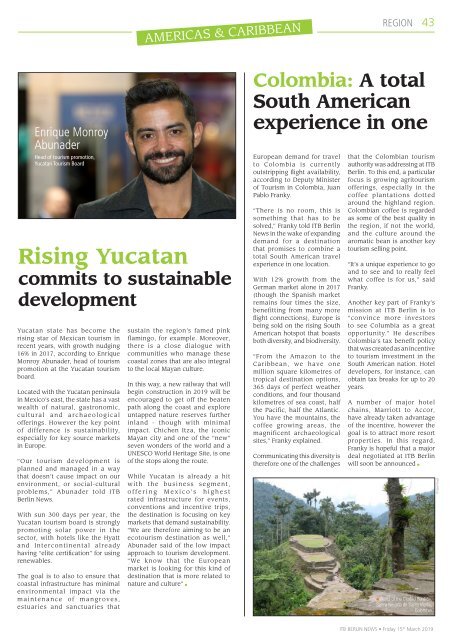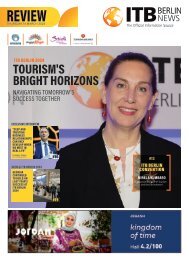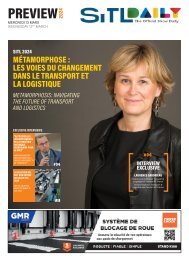ITB Berlin News 2019 - Review Edition
Create successful ePaper yourself
Turn your PDF publications into a flip-book with our unique Google optimized e-Paper software.
AMERICAS & CARIBBEAN<br />
REGION<br />
43<br />
Enrique Monroy<br />
Abunader<br />
Head of tourism promotion,<br />
Yucatan Tourism Board<br />
Rising Yucatan<br />
commits to sustainable<br />
development<br />
Yucatan state has become the<br />
rising star of Mexican tourism in<br />
recent years, with growth nudging<br />
16% in 2017, according to Enrique<br />
Monroy Abunader, head of tourism<br />
promotion at the Yucatan tourism<br />
board.<br />
Located with the Yucatan peninsula<br />
in Mexico’s east, the state has a vast<br />
wealth of natural, gastronomic,<br />
cultural and archaeological<br />
offerings. However the key point<br />
of difference is sustainability,<br />
especially for key source markets<br />
in Europe.<br />
“Our tourism development is<br />
planned and managed in a way<br />
that doesn’t cause impact on our<br />
environment, or social-cultural<br />
problems,” Abunader told <strong>ITB</strong><br />
<strong>Berlin</strong> <strong>News</strong>.<br />
With sun 300 days per year, the<br />
Yucatan tourism board is strongly<br />
promoting solar power in the<br />
sector, with hotels like the Hyatt<br />
and Intercontinental already<br />
having “elite certification” for using<br />
renewables.<br />
The goal is to also to ensure that<br />
coastal infrastructure has minimal<br />
environmental impact via the<br />
maintenance of mangroves,<br />
estuaries and sanctuaries that<br />
sustain the region’s famed pink<br />
flamingo, for example. Moreover,<br />
there is a close dialogue with<br />
communities who manage these<br />
coastal zones that are also integral<br />
to the local Mayan culture.<br />
In this way, a new railway that will<br />
begin construction in <strong>2019</strong> will be<br />
encouraged to get off the beaten<br />
path along the coast and explore<br />
untapped nature reserves further<br />
inland - though with minimal<br />
impact. Chichen Itza, the iconic<br />
Mayan city and one of the “new”<br />
seven wonders of the world and a<br />
UNESCO World Heritage Site, is one<br />
of the stops along the route.<br />
While Yucatan is already a hit<br />
with the business segment,<br />
offering Mexico’s highest<br />
rated infrastructure for events,<br />
conventions and incentive trips,<br />
the destination is focusing on key<br />
markets that demand sustainability.<br />
“We are therefore aiming to be an<br />
ecotourism destination as well,”<br />
Abunader said of the low impact<br />
approach to tourism development.<br />
“We know that the European<br />
market is looking for this kind of<br />
destination that is more related to<br />
nature and culture”<br />
Colombia: A total<br />
South American<br />
experience in one<br />
European demand for travel<br />
to Colombia is currently<br />
outstripping flight availability,<br />
according to Deputy Minister<br />
of Tourism in Colombia, Juan<br />
Pablo Franky.<br />
“There is no room, this is<br />
something that has to be<br />
solved,” Franky told <strong>ITB</strong> <strong>Berlin</strong><br />
<strong>News</strong> in the wake of expanding<br />
demand for a destination<br />
that promises to combine a<br />
total South American travel<br />
experience in one location.<br />
With 12% growth from the<br />
German market alone in 2017<br />
(though the Spanish market<br />
remains four times the size,<br />
benefitting from many more<br />
flight connections), Europe is<br />
being sold on the rising South<br />
American hotspot that boasts<br />
both diversity, and biodiversity.<br />
“From the Amazon to the<br />
Caribbean, we have one<br />
million square kilometres of<br />
tropical destination options,<br />
365 days of perfect weather<br />
conditions, and four thousand<br />
kilometres of sea coast, half<br />
the Pacific, half the Atlantic.<br />
You have the mountains, the<br />
coffee growing areas, the<br />
magnificent archaeological<br />
sites,” Franky explained.<br />
Communicating this diversity is<br />
therefore one of the challenges<br />
that the Colombian tourism<br />
authority was addressing at <strong>ITB</strong><br />
<strong>Berlin</strong>. To this end, a particular<br />
focus is growing agritourism<br />
offerings, especially in the<br />
coffee plantations dotted<br />
around the highland region.<br />
Colombian coffee is regarded<br />
as some of the best quality in<br />
the region, if not the world,<br />
and the culture around the<br />
aromatic bean is another key<br />
tourism selling point.<br />
“It’s a unique experience to go<br />
and to see and to really feel<br />
what coffee is for us,” said<br />
Franky.<br />
Another key part of Franky’s<br />
mission at <strong>ITB</strong> <strong>Berlin</strong> is to<br />
“convince more investors<br />
to see Columbia as a great<br />
opportunity.” He describes<br />
Colombia’s tax benefit policy<br />
that was created as an incentive<br />
to tourism investment in the<br />
South American nation. Hotel<br />
developers, for instance, can<br />
obtain tax breaks for up to 20<br />
years.<br />
A number of major hotel<br />
chains, Marriott to Accor,<br />
have already taken advantage<br />
of the incentive, however the<br />
goal is to attract more resort<br />
properties. In this regard,<br />
Franky is hopeful that a major<br />
deal negotiated at <strong>ITB</strong> <strong>Berlin</strong><br />
will soon be announced<br />
Ruins of the Ciudad Perdida,<br />
Sierra Nevada de Santa Marta,<br />
Colombia<br />
© Gavin Rough<br />
<strong>ITB</strong> BERLIN NEWS • Friday 15 th March <strong>2019</strong>

















